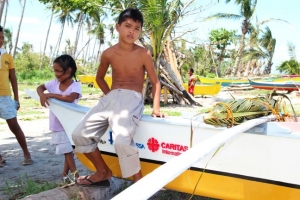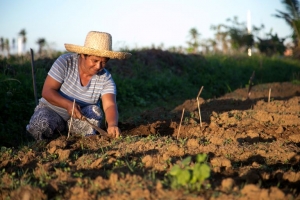
Boats distributed by Caritas in Palo.
Credit Mark Mitchell/Caritas Aotearoa New Zealand
Caritas is shifting its focus in the aftermath of Super Typhoon Haiyan in the Philippines from emergency relief to longer-term recovery.
Haiyan (local name ‘Yolanda’) tore across the Philippines on Friday 8 November, leaving a trail of destruction in its wake. It is believed to be the strongest tropical cyclone on record to make landfall.
The storm’s impact has been enormous, with over 16 million people affected and over 4 million forced from their homes. Over 1.1 million homes were damaged, about half of them completely destroyed.
The Great Storm tells the dramatic story of how Caritas helped survivors left in the wake of Super Typhoon Haiyan.
Caritas as first responder
The Catholic Church in the Philippines was one of the first responders, mobilising resources as soon as the typhoon hit. Caritas Internationalis reached 275,000 people through local churches in nine dioceses with a €5.6 million emergency aid programme.
Cardinal Luis Antonio Tagle, Archbishop of Manila, praised the role the Caritas confederation has played.
“Caritas Internationalis and Caritas Philippines-NASSA have spearheaded this whole coordination work. The different local Caritas worked together and made Caritas Philippines the clearing house of all their efforts,” said Cardinal Tagle.
With a huge outpouring of support from the Caritas network, the emergency programme was fully funded by over 30 different Caritas organisations from around the world.

Caritas has supplied tools and seeds in the Visayas to help farmers recover. Credit: Jen Hardy/CRS
Highlights so far
- Providing 125,000 people with immediate food and household items and hygiene kits to 275,000 people.
- At least 100,000 people received shelter through emergency kits including plastic tarpaulins and tools.
- Fishing boats and small-scale farming kits helped 13,000 families get back on their feet.
- Cash grants were given to 20,000 extremely vulnerable families, which also helped revive the local economy.
We will rise up from this
With relief activities beginning to wind down, the focus is now shifting on providing longer-term recovery support to build back their lives better and reduce reliance on emergency aid.
Caritas Internationalis is launching a €9.7 million one-year recovery programme for 100,000 people in the worst hit areas. All Caritas programmes are developed with the participation of the communities they aim to help.
The programme includes building permanent homes for 3700 families. The buildings will be better able to withstand future typhoons as the Philippines experiences an average 22 typhoons annually.
Caritas Philippines will also provide clean water for 24,000 people. And give 10,000 families a brighter future by supporting them to earn a living.
This next step is essential in bridging the gap before longer-term development activities and is crucial in ensuring that there is no relapse into humanitarian crisis.
Babangon po kami means ‘we will rise up from this’ in the Philippines and Caritas is committed to be part of that journey as the country builds a more resilent future.
